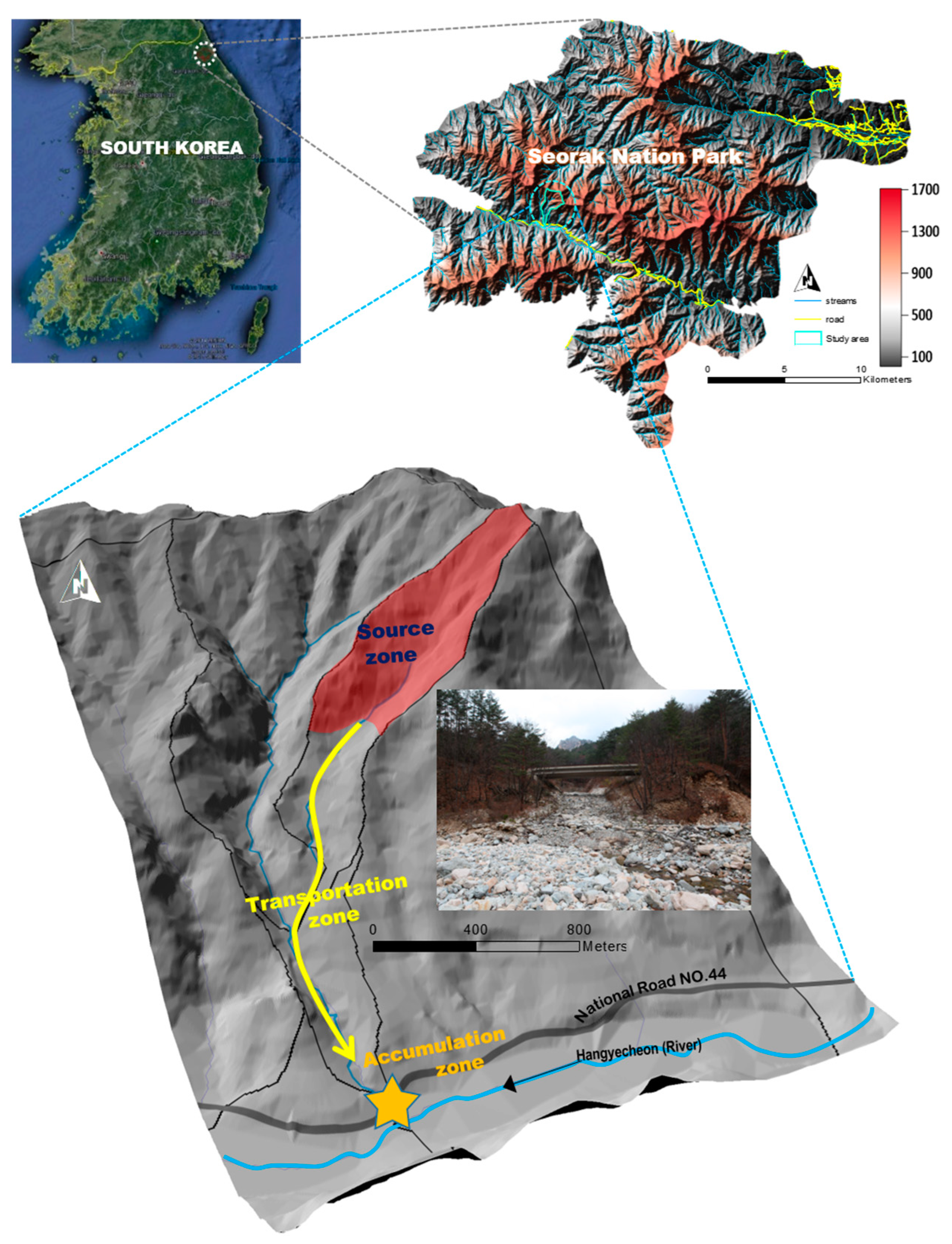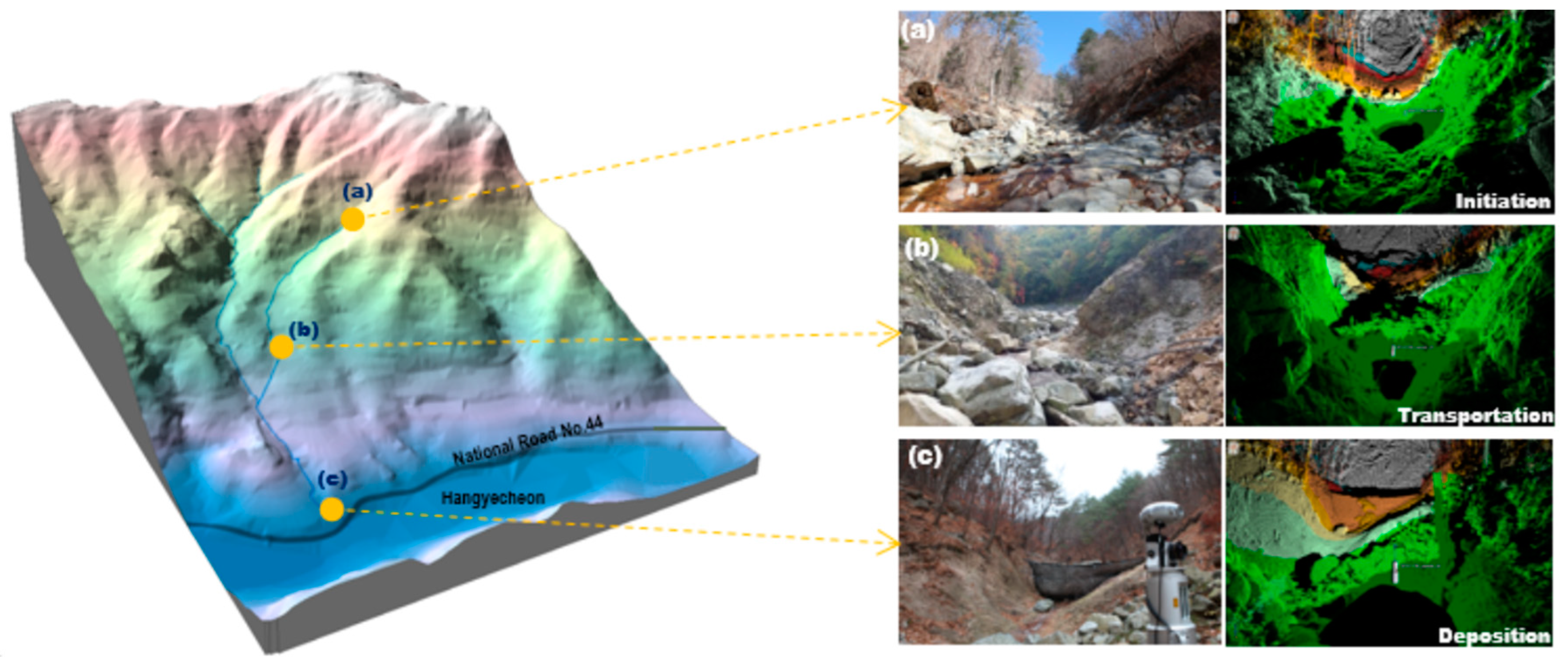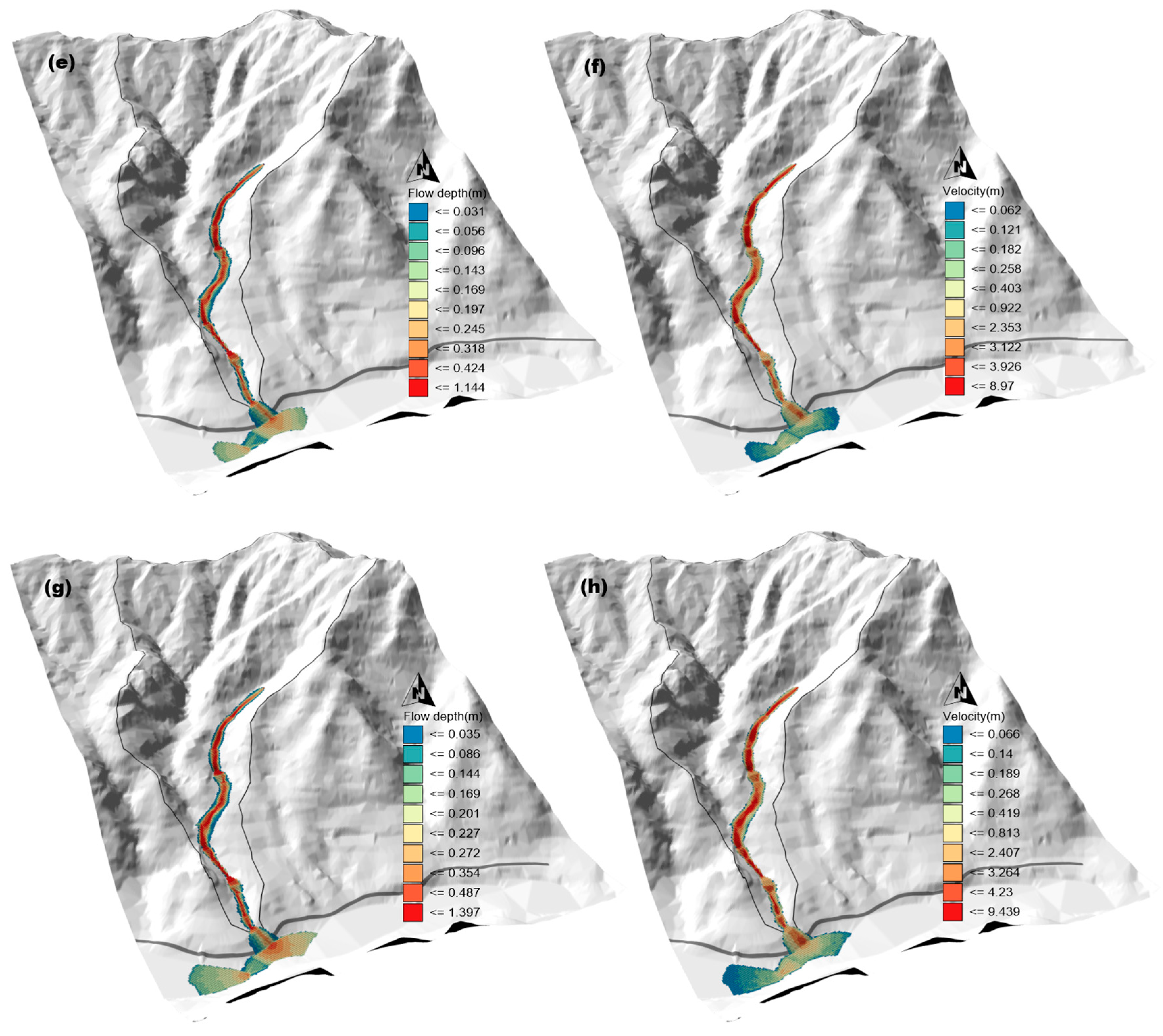Analysis of Debris Flow Damage Using High-Resolution Topographical Data
Abstract
1. Introduction
2. Methods
2.1. Study Area and Field Survey
2.2. Terrestrial LiDAR
2.3. FLO-2D
3. Terrain Data and FLO-2D Simulation Analysis
3.1. Characteristic of Terrain Data
3.2. FLO-2D Simulation
4. Conclusions
- (1)
- Employing on-site monitoring and terrestrial LiDAR technology, the actual extent of debris flow was meticulously scanned, resulting in the creation of high-resolution DEM spatial data. These data facilitated the calculation and analysis of the deposition and diffusion areas downstream from the debris flow generation zone, estimating it to be approximately 21,300 square meters.
- (2)
- Debris flow phenomena were replicated using the FLO-2D model. The simulation incorporated actual rainfall data from the event and probabilistic rainfall patterns associated with return periods of 30, 50, and 100 years. The simulation using actual rainfall revealed a maximum flow depth of 0.86 m, a peak velocity of 8.254 m per second, and a diffusion area of around 20,900 square meters. This closely aligned with the findings of the LiDAR survey, which indicated a value of 21,300 square meters. In the case of the 100-year frequency, the maximum flow depth increased to 1.397 m, the peak velocity surged to 9.439 m per second, and the diffusion area expanded to 40,725 square meters. Across simulations, it was observed that flow depth, velocity, and diffusion area exhibited gradual increments in response to varying flow rates.
- (3)
- Risk assessment was conducted by overlapping the debris flow disaster map with an aerial photograph captured during the disaster. The debris flow intensity index (hv) was extracted for Jangsu Bridge 5 (National Highway 44), leading to the creation of a disaster risk map. This analysis indicated a high risk of debris flow disaster for the majority of the debris flow generation zone and the flow path towards transportation. In the downstream region, actual debris flow encroached upon the road and entered the river, yielding a high level of risk.
Author Contributions
Funding
Data Availability Statement
Conflicts of Interest
References
- Sidel, R.C.; Ziegler, A.D.; Negishi, J.N.; Nik, A.R.; Siew, R.; Turkelboom, F. Erosion Processes in Steep Terrain-Truths, Myths, and Uncertainties Related to Forest Management in Southeast Asia. For. Ecol. Manag. 2006, 224, 199–225. [Google Scholar] [CrossRef]
- Wang, N.S.; Yi, R.H.; Liu, D. A solution method to the problem proposed by Wang in voting systems. J. Comput. Appl. Math. 2008, 221, 106–113. [Google Scholar] [CrossRef]
- O’Brien, J.S.; Julien, P.Y. Laboratory analysis of mud flow properties. J. Hydraul. Eng. 1988, 8, 877–887. [Google Scholar] [CrossRef]
- O’Brien, J.S.; Julien, P.Y.; Fullerton, W.T. Twodimensional water flood and mudflow simulation. J. Hydraul. Eng. 1993, 119, 244–261. [Google Scholar] [CrossRef]
- Iverson, R.M.; Ried, M.E.; LaHusen, R.G. Debris flow mobilization from landslides. Annu. Rev. Earth Planet. Sci. 1997, 25, 85–138. [Google Scholar] [CrossRef]
- Imran, J.; Harff, P.; Parker, G. A numerical model of submarine debris flow with graphical user interface. Comput. Geosci. 2001, 27, 717–729. [Google Scholar] [CrossRef]
- Takahashi, T.; Tsujimoto, H. Mechanics of granular flow in inclined chute. J. Hydraul. Coast. Environ. Eng. JSCE 1984, 565, 57–71. [Google Scholar] [CrossRef] [PubMed][Green Version]
- Kim, K.S. Characteristics of Basin topography and Rainfall Triggering Debris Flow. J. Civ. Environ. Eng. Res. KSCE 2008, 28, 236–271. [Google Scholar]
- Fan, L.; Lehmann, P.; McArdell, B.; Or, D. Linking rainfall-induced landslides with debris flows runout patterns towards catchment scale hazard assessment. Geomorphology 2017, 280, 1–15. [Google Scholar] [CrossRef]
- Mark, T.J.; Van Westen, C.J. Deterministic Modelling in GIS-Based Landslide Hazard Assessment. In Geographical Information Systems in Assessing Natural Hazards; Springer: Dordrecht, The Netherlands, 1995; pp. 57–77. [Google Scholar]
- Lin, J.Y.; Yang, M.D.; Lin, B.R.; Lin, P.S. Risk assessment of debris flows in Songhe Stream, Taiwan. Eng. Geol. 2011, 123, 100–112. [Google Scholar] [CrossRef]
- Choi, J.H. Analysis of Debris Flow of Chun-chon Landslide Area using Numerical Methods. J. Eng. Geol. 2017, 27, 59–66. [Google Scholar]
- Lo, C.M.; Feng, Z.Y.; Chang, K.T. Landslide hazard zoning based on numerical simulation and hazard assessment. Geomat. Nat. Hazards Risk 2018, 9, 368–388. [Google Scholar] [CrossRef]
- An, H.; Ouyang, C.; Wang, F.; Xu, Q.; Wang, D.; Yang, W.; Fan, T. Comprehensive analysis and numerical simulation of a large debris flow in the Meilong catchment, China. Eng. Geol. 2022, 298, 106546. [Google Scholar] [CrossRef]
- Kim, Y.J.; Kim, T.W.; Kim, D.K.; Yoon, J.S. Debris flow characteristics and sabo dam function in urban steep slopes. J. Korea Water Resour. Assoc. KWRA 2020, 53, 627–636. [Google Scholar]
- Zhang, T.; Yin, Y.; Li, B.; Liu, X.; Wang, M.; Gao, Y.; Wan, J.; Gnyawali, K.R. Characteristics and dynamic analysis of the February 2021 long-runout disaster chain triggered by massive rock and ice avalanche at Chamoli, Indian Himalaya. J. Rock Mech. Geotech. Eng. 2023, 15, 296–308. [Google Scholar] [CrossRef]
- Ji, J.; Zhang, C.; Gao, Y.; Kodikara, J. Reliability-based design for geotechnical engineering: An inverse FORM approach for practice. Comput. Geotech. 2019, 111, 22–29. [Google Scholar] [CrossRef]
- Ji, J.; Wang, C.W.; Gao, Y.; Zhang, L. Probabilistic investigation of the seismic displacement of earth slopes under stochastic ground motion: A rotational sliding block analysis. Can. Geotech. J. 2020, 58, 952–968. [Google Scholar] [CrossRef]
- Ji, J.; Cui, H.; Zhang, T.; Song, J.; Gao, Y. A GIS-based tool for probabilistic physical modelling and prediction of landslides: GIS-FORM landslide susceptibility analysis in seismic areas. Landslides 2022, 19, 2213–2231. [Google Scholar] [CrossRef]
- Liu, Q.; Huang, D.; Huang, Z.; Zhang, B.; Xu, X. Total probababilistic measure for the potential risk of regional roads exposed to landslides. Reliab. Eng. Syst. Saf. 2022, 228, 108822. [Google Scholar] [CrossRef]
- Tang, Y.; Guo, Z.; Wu, L.; Hong, B.; Feng, W.; Su, X.; Li, Z.; Zhu, Y. Assessing Debris Flow Risk at a Catchment Scale for an Economic Decision Based on the LiDAR DEM and Numerical Simulation. Front. Earth Sci. 2022, 10, 1–21. [Google Scholar] [CrossRef]
- Ministry of Public Safety and Security. Development of Precision Hazard Risk Assessment Methods and Hazard Maps for Landslides and Debris Flows Due to Heavy Rainstorms; MPSS: Sejong, Republic of Korea, 2015. [Google Scholar]
- O’Brien, J.S. FLO-2D User Manual. FLO-2D Software, Inc.: Nutrioso, AZ, USA, 2018. [Google Scholar]
- Fiebiger, G. Hazard mapping in Austria. J. Torrent Avalanche Landslide Rockfall Eng. 1997, 134, 93–104. [Google Scholar]










| Return Period of Rainfall (mm) | ||||
|---|---|---|---|---|
| Duration | Event Rainfall of Debris Flow | 30 Year | 50 Year | 100 Year |
| 60 min | 49.5 | 61.8 | 66.9 | 73.7 |
| Source | (Dynes/) | (Poises) | ||
|---|---|---|---|---|
| Aspen Pit 1 | 0.181 | 25.7 | 0.0360 | 22.1 |
| Aspen Pit 2 | 2.72 | 10.4 | 0.0538 | 14.5 |
| Aspen Natural Soil | 0.152 | 18.7 | 0.00136 | 28.4 |
| Aspen Mine Fill | 0.0473 | 21.1 | 0.128 | 12.0 |
| Aspen Watershed | 0.0383 | 19.6 | 0.000495 | 27.1 |
| Aspen Mine Source Area | 0.291 | 14.3 | 0.000201 | 33.1 |
| Glenwood 1 | 0.0345 | 20.1 | 0.00283 | 23.0 |
| Glenwood 2 | 0.0765 | 16.9 | 0.0648 | 6.20 |
| Glenwood 3 | 0.000707 | 29.8 | 0.000632 | 19.9 |
| Glenwood 4 | 0.00172 | 29.5 | 0.000602 | 33.1 |
| Surface | Range of K |
|---|---|
| Concrete/asphalt | 24–108 |
| Bare sand | 30–120 |
| Graded surface | 90–400 |
| Bare clay–loam soil, eroded | 100–500 |
| Sparse vegetation | 1000–4000 |
| Short prairie grass | 3000–10,000 |
| Bluegrass sod | 7000–50,000 |
| Manning Coefficient (n) | Viscosity vs. Sediment Concentration | Yield Stress vs. Sediment Concentration | Laminar Flow Resistance (K) | ||
|---|---|---|---|---|---|
| Forest | α | β | α | β | 500 |
| 0.02 | 0.0383 | 19.6 | 0.000495 | 27.1 | |
| Maximum Flow Depth (m) | Mean Flow Depth (m) | Maximum Flow Velocity (m/s) | Mean Flow Velocity (m/s) | Diffusion Area (m2) | |
|---|---|---|---|---|---|
| Case I | 0.861 | 0.192 | 8.254 | 1.057 | 20,900 |
| Case II | 1.040 | 0.199 | 8.800 | 1.423 | 29,450 |
| Case III | 1.144 | 0.202 | 8.970 | 1.442 | 35,625 |
| Case IV | 1.397 | 0.237 | 9.439 | 1.492 | 40,725 |
| Debris Flow Risk | Maximum Simulated Accumulation Depth h (m) | Relation | Maximum Simulated Accumulation Depth and Velocity vh (m2/s) |
|---|---|---|---|
| High | h >1.0 m | OR | vh > 1.0 m2/s |
| Medium | 0.2 m < h < 1.0 m | AND | 0.2 m < vh < 1.0 m2/s |
| Low | 0.2 m < h < 1.0 m | AND | vh < 0.2 m2/s |
Disclaimer/Publisher’s Note: The statements, opinions and data contained in all publications are solely those of the individual author(s) and contributor(s) and not of MDPI and/or the editor(s). MDPI and/or the editor(s) disclaim responsibility for any injury to people or property resulting from any ideas, methods, instructions or products referred to in the content. |
© 2023 by the authors. Licensee MDPI, Basel, Switzerland. This article is an open access article distributed under the terms and conditions of the Creative Commons Attribution (CC BY) license (https://creativecommons.org/licenses/by/4.0/).
Share and Cite
Oh, C.; Jun, K. Analysis of Debris Flow Damage Using High-Resolution Topographical Data. Water 2023, 15, 3454. https://doi.org/10.3390/w15193454
Oh C, Jun K. Analysis of Debris Flow Damage Using High-Resolution Topographical Data. Water. 2023; 15(19):3454. https://doi.org/10.3390/w15193454
Chicago/Turabian StyleOh, Chaeyeon, and Kyewon Jun. 2023. "Analysis of Debris Flow Damage Using High-Resolution Topographical Data" Water 15, no. 19: 3454. https://doi.org/10.3390/w15193454
APA StyleOh, C., & Jun, K. (2023). Analysis of Debris Flow Damage Using High-Resolution Topographical Data. Water, 15(19), 3454. https://doi.org/10.3390/w15193454







